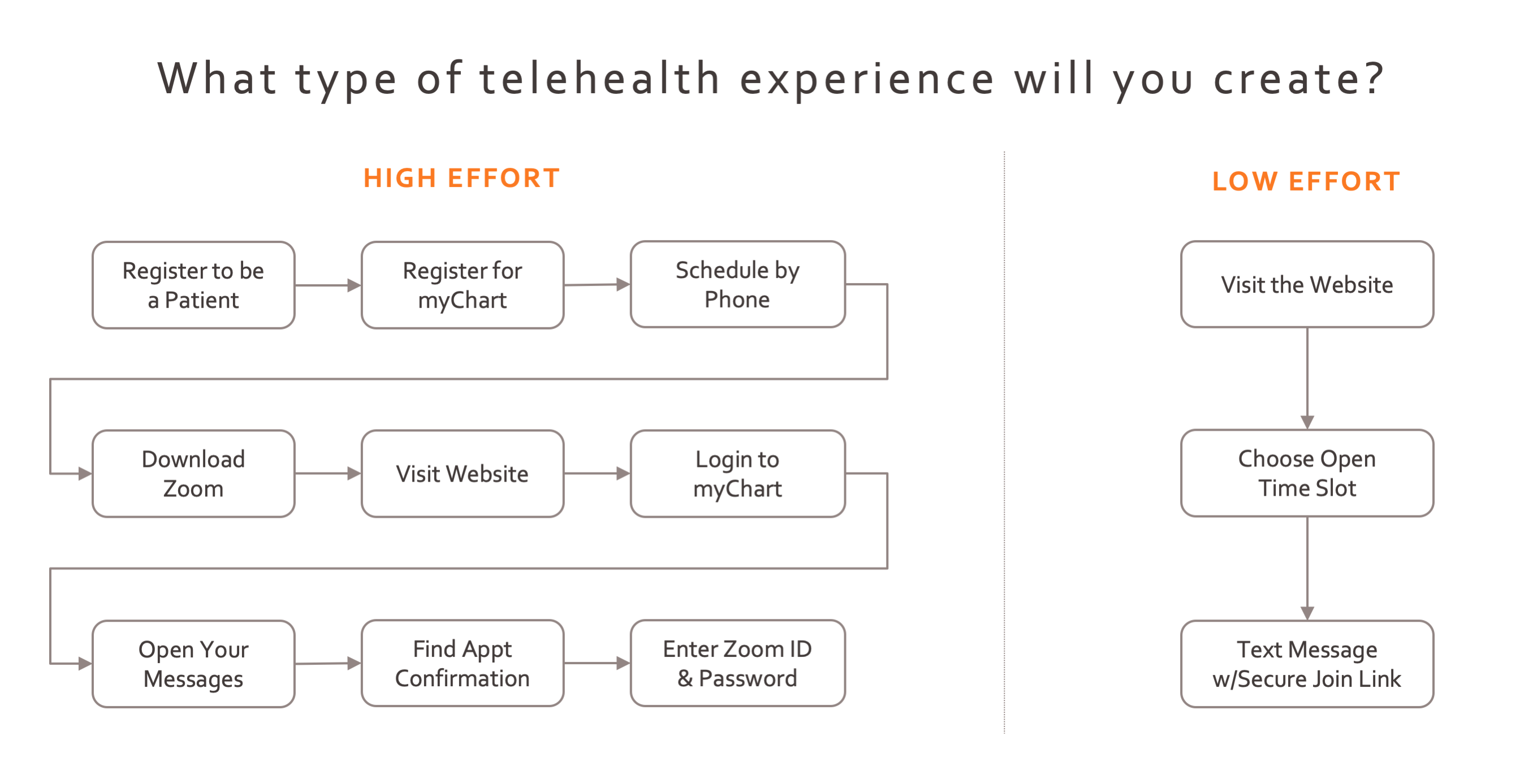One month ago, telehealth was a distant roadmap item for most hospitals. Today’s it’s a necessity. Hospitals across the country are losing more than 50% of their revenue[1] due to cancelled appointments and elective surgeries. To counter the sudden “bleeding out,” most healthcare organizations have rolled out telehealth in just 3 weeks.
But has the industry been forced to move too quickly?
It took Amazon 9 years to really get things right [2]. So, even with all the telehealth solutions on the market, bringing healthcare online in less than a month is an audacious goal.
Now, no one really is to blame for doing their best to get something out. But, in the rush to fill the current need, many of today’s telehealth experiences feel more like a long and winding path – rather than the convenient and easy solution consumers expect.
For the moment, consumers are probably a little forgiving of the disconnected nature of the experience. But how long will that goodwill last? Look what happened to Blockbuster when people no longer had to drive to the store to rent a movie.
When we come out on the other side of COVID-19, consumers will have more choice than ever and the telehealth experience you create today will be the thing that sets you apart.

Telehealth is breaking down the barriers of distance and carving out a new competitive landscape.
We already know that consumers are driven by convenience and instant gratification. By a 4-to-1 margin[3], they prefer to see a physician with less availability but who has online scheduling, compared with an identical physician who has greater availability but no online scheduling.
And Google just announced[4] it will make it easier to connect with providers offering telehealth – directly from search results. It’s no secret know that Google values easy-to-use experiences - so it’s only a matter of time before Google issues a higher rank to hospitals offering the most seamless telehealth experience.
Meanwhile, for those with a disconnected experience, it’s going to be a real challenge. Especially when you consider that telehealth is just one touchpoint in the digital patient experience. We are in the midst of a wholesale shift in the way we monitor, motivate, educate, and treat patients online.
The winners will be those that create the most frictionless experience across the patient journey.
According to Gartner, when an experience requires a lot of effort, customers are 10x more likely to become disloyal than when the experience has low friction.
Amazon doesn’t send you to a separate website and portal just to place an order. Uber doesn’t make you log back into the app every time you want to see how close your driver is.
So why is it that patients should have to wait 40 minutes[5] for a telehealth appointment – sometimes only to find out they should have gone in for an x-ray first? Or that it requires a medical degree to understand your cholesterol levels? And why is the patient portal a confusing, separate experience from the website? Or after a significant surgery, why doesn’t anyone call to check in on you?
What’s good for the patient experience is also good for providers.
Self-service symptom checkers can triage patients to the right care point without taxing your call center. Personalized digital lab reports can inspire healthier habits – protecting value-based care payments. EPIC has APIs available today that allow you to integrate the portal and website. And post-surgery automated, intelligent emails and text messages can let patients know you care without adding more to physicians’ workload.
While there are many other moments in the digital patient journey to consider, it’s impractical to think any single healthcare organization will solve this overnight.
If we’ve learned anything from the recent rush to telehealth, it’s that everyone needs a little time to get this right. And, rest assured, when an industry goes through this level of disruption, it’s not typically the first to market that wins the race. With some careful planning now, you can chart a clear course to connect your digital patient experience – and connect better with patients.
Get started by downloading our roadmap for digital patient experience. It's full of specific strategies to consider across your digital patient journey.
-----------
As a healthcare experience integrator, White Rhino helps organizations develop and execute integrated digital roadmaps to drive patient preference and loyalty. Using a unique mix of design thinking, neuroscience, and psychology, we bring the voice of the consumer to your digital patient experience.
[1] https://www.healthcarefinancenews.com/news/hospitals-furlough-staff-reduce-physician-salaries-waiting-cares-act-funds
[2] https://www.inc.com/drew-hendricks/5-successful-companies-that-didn-8217-t-make-a-dollar-for-5-years.html
[3] https://www.healthleadersmedia.com/innovation/assessing-online-scheduling-emerging-trend-scheduling-physician-appointments
[4] https://www.beckershospitalreview.com/consumerism/google-rolls-out-tools-in-search-and-maps-to-connect-people-with-physicians-telehealth.html
[5] https://ehealthcarestrategy.com/news-from-the-front-healthcare-shifts-into-high-gear-to-address-the-coronavirus/




